Last updated: November 17, 2020
Article
A "Taste" of Fort Vancouver
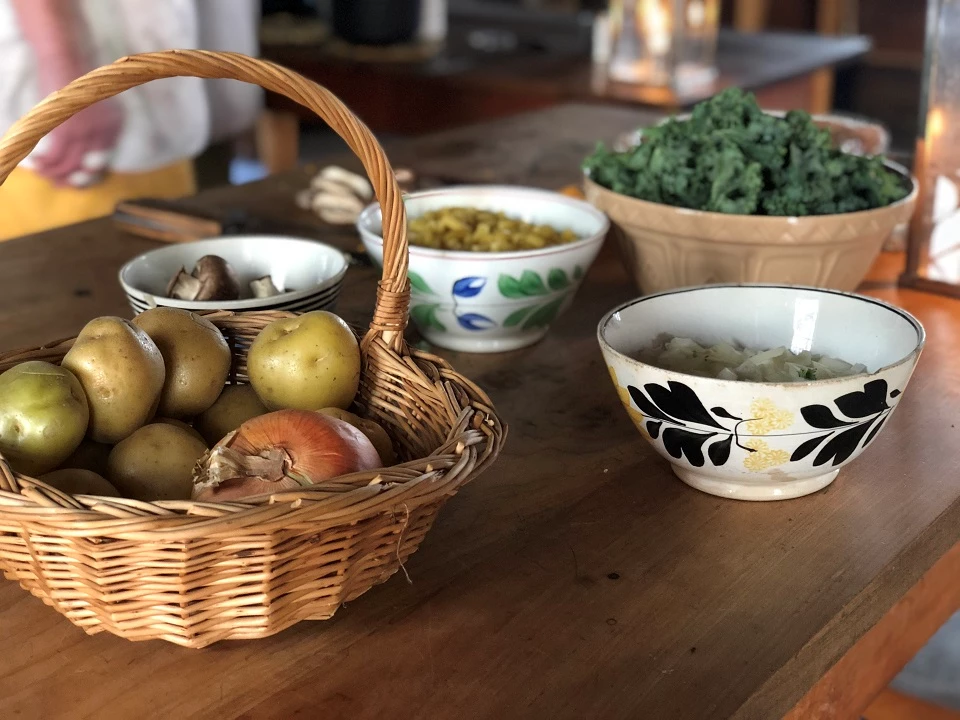
NPS Photo
As many of us stay home to help slow the spread of COVID-19, we find ourselves cooking at home more often. Read on to learn about the history of dining and food at Fort Vancouver, and try your hand at historically-inspired recipes developed by Volunteer-in-Parks Bob Prinz, who demonstrates historic cooking techniques in the Kitchen at Fort Vancouver National Historic Site.
Food at Fort Vancouver
At Fort Vancouver and its employee Village, dining was an important tradition that brought people together, much like it does today. Three times a day, the fort bell would ring to signal the beginnings of a meal: 8 am for breakfast, 1 pm for dinner (what we would now call lunch), and 6 pm for supper.
Inside the fort, meals were made in the Kitchen and served to Hudson's Bay Company (HBC) officers, clerks, and visitors in the Chief Factor's House Mess Hall. The wives and daughters of these men, who were often Native American or Métis women, ate separately in the Ladies' Mess Hall. They may also have made their own meals in the fort's Bachelor's Quarters. This long, rectangular building inside the fort contained several apartments where, despite its name, HBC officers, clerks, and their families lived. The meals served at the Chief Factor's House were inspired by British and French-Canadian cooking, but not all residents of the fort were accustomed to this kind of food. Amelia Douglas, the Métis wife of Chief Trader James Douglas, remained "very fond of bitterroot, camas, and buffalo tongue," and was described as "much bored" by the European-style food served to her.
In the Village, Company employees were given weekly food rations, usually consisting of peas, tallow (rendered animal fat), salmon, and bread or potatoes. However, these rations were only enough for the male employees, not their families. Native American or Métis wives living in the Village supplemented these rations with foraged fruits, roots, berries and wild game, which they prepared in their traditional ways. They may also have kept gardens near their homes, where they could grow their own food.
Recipes to Try at Home
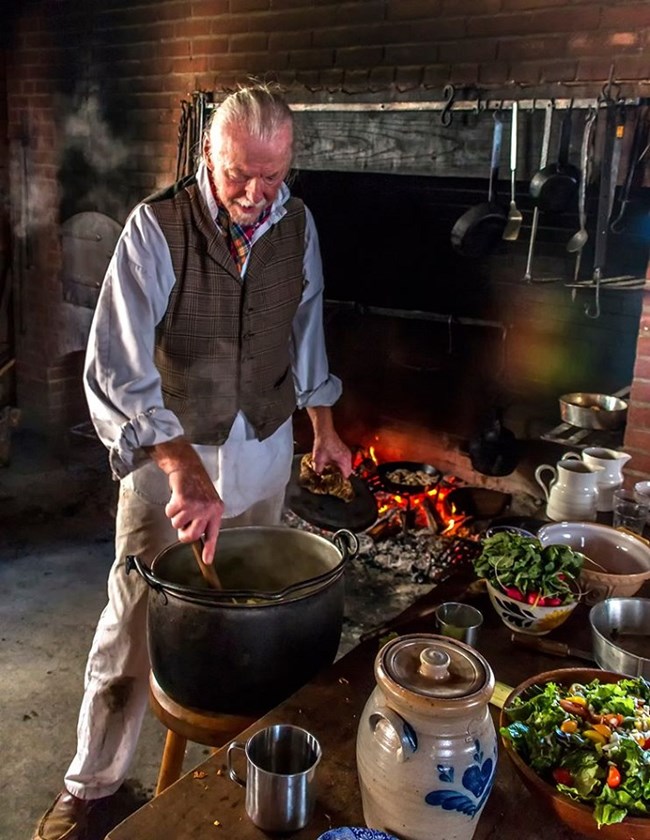
NPS Photo
About the Chef
These historically-inspired recipes were developed or adapted from historic recipes by Bob Prinz, who has been volunteering at Fort Vancouver National Historic Site for six years. His interest in cooking and culinary experience goes back many years to watching his grandmothers, mother, and father cooking in the kitchen, over the hearth, and on the barbecue. The experience not only sparked his interest in cooking, but also with experimentation. As a young adult, Bob took classes and received certification with the Culinary Institute of America in New Haven, Connecticut, and with the Cordon Bleu School in Boston, Massachusetts. The highlight of that experience was having Julia Child as one of the instructors. After moving to Europe in 1975, additional classes included Italian cooking school, Thai cooking school, studying the molecular gastronomy of Ferran Adrià, being certified by the Comité de Vin, and numerous kitchen experiences with chefs Roger Vergé, Andre Surmain, and Enzo Gazella, amongst others. Bob is pleased to be part of the volunteer corps at Fort Vancouver National Historic Site and the National Park Service.
The Recipes
No specific historic documentation exists to tell us what recipes the cooks at Fort Vancouver used. There were records kept of the vegetables grown in the fort's garden, livestock kept at the fort's farms, fruits grown in the orchards, and what was foraged or obtained through trade. Using these records, as well as recipes from historic cookbooks, volunteer Bob Prinz has developed these adaptations to try at home. The recipes here have been excerpted from his upcoming book, Fort Vancouver Recipes from the Historic Kitchen in the Mid-19th Century.
Bon appetit!
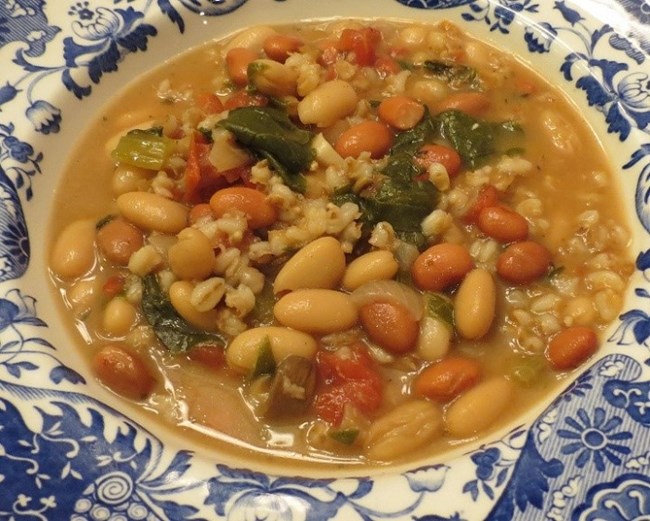
Photo: Bob Prinz
Bean, Kale, and Barley Soup
Appetizer Course
Serves: 6
Ingredients
- 1 tablespoon butter
- 1 carrot, diced
- 1 celery rib, diced
- 1/2 cup onion, diced
- 4 cups beef broth (or vegetable broth)
- 4 cups water
- 1 cup tomatoes, diced
- 1 cup cooked white beans
- 4 cups kale, cleaned, trimmed, and chopped
- 1 cup pearl barley
- ½ teaspoon dried sage
- ½ teaspoon dried thyme
- ½ teaspoon pepper
- ¼ teaspoon salt
- In a large soup pot, melt butter over medium heat; sauté carrot, celery, and onion for 4-5 minutes.
- Add broth, water, tomatoes, beans, kale, barley, and seasonings; bring to a boil. Reduce heat; simmer, covered, for 30-35 minutes, stirring occasionally until the barley is soft.
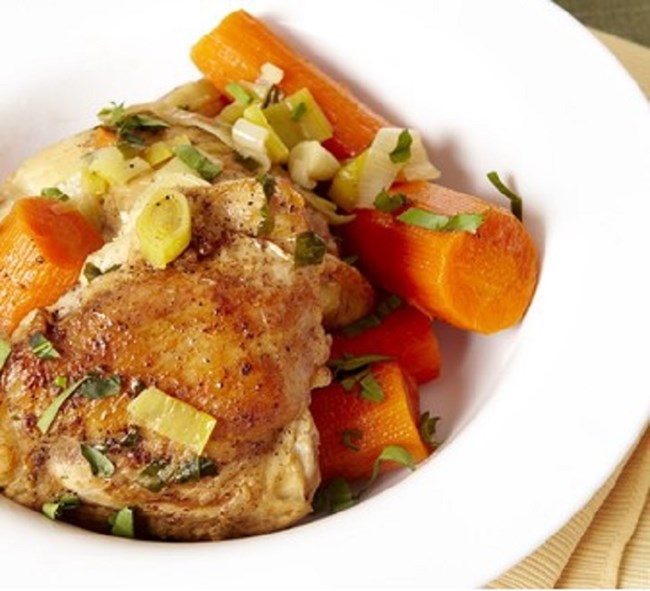
Photo: Bob Prinz
Chicken Fricassee
Main Course
This recipe has been adapted from Directions for Cookery, in its Various Branches, published in 1840.
Serves: 6
Ingredients
- 6-8 chicken thighs, bone-in
- Salt and pepper
- Olive oil
- 1 onion, chopped
- 2 cloves garlic, minced
- 1 tablespoon flour
- ½ cup white wine
- 1½ cups chicken stock
- ½ teaspoon dried sage
- ½ teaspoon thyme
- ½ cup heavy cream
- 1 carrot, diced and blanched
- 1 leek, white and light green parts, diced and blanched
- Preheat oven to 350° F.
- Season the chicken with salt and pepper. Heat olive oil in an oven-safe skillet and sauté chicken pieces, but do not brown. Remove to a plate and reserve for later.
- Add onions and garlic to skillet and sauté for about 5 minutes until the onions become translucent. Add flour and continue sautéing, stirring frequently for another 5 minutes.
- Deglaze the pan with the wine, scraping up any brown pieces from the bottom of the pan.
- Add the chicken stock, herbs, and the reserved chicken and bring to a simmer.
- Cover the skillet and braise the mixture in the oven for 45 minutes.
- Remove the skillet from the oven and add the heavy cream and the blanched vegetables. Bring to a light boil and then let it simmer for about 15 minutes.
- To serve, place chicken pieces on aplate and ladle some sauce over. Traditionally chicken fricasee is served with mashed potatoes and a seasonal vegetable, but pasta or salad would also go well with this dish.
Creamed Cabbage and Carrots
Main Course, Vegetarian Alternative
Serves: 6
Ingredients
- 3 cups cabbage, shredded
- 4 large carrots, peeled and cut into 1-inch pieces
- 2 tablespoons butter
- 2 cups half and half
- ½ teaspoon pepper, or to taste
- ½ teaspoon salt, or to taste
- 4 tablespoons flour
Directions
- In separate pots, boil cabbage and carrots until tender, approximately 15-20 minutes, drain well.
- Make a roux from the butter and flour, stirring constantly until it turns a light brown.
- Gradually add half and half, stirring until thickened.
- Add cabbage, carrots, salt, and pepper, stir to mix together.
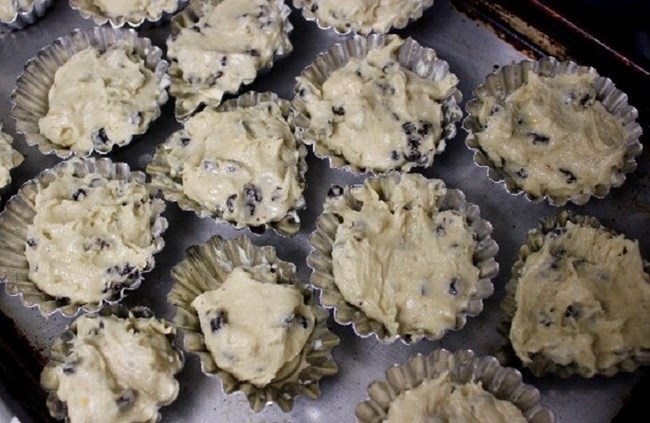
Photo: Bob Prinz
Queen Cakes
Dessert
This recipe has been adapted from Mrs. Beeton's The Book of Household Management, published in London in 1861. The original recipes would have used small tin molds or muffin tins. In this adapted version, a muffin or cupcake pan is used lightly buttered, or with muffin/cupcake papers.
Ingredients
- 1 stick (8 tablespoons) unsalted butter, room temperature
- 2 cups less 2 tablespoons all-purpose flour
- 1 cup sugar
- ¾ cup dried currants
- 2 eggs, room temperature
- ¼ cup cream
- 1 teaspoon grated lemon zest
- ½ teaspoon baking soda
Directions
- Preheat oven to 325° F. Generously butter about 20 small (approx. 2") tart molds or a muffin pan with 12 wells. If using molds, place them on a baking sheet.
- In a large bowl, beat the stick of butter until light, about 1 minute. Slowly mix in the flour, add the sugar and currants, and mix well.
- In a medium bowl, beat the eggs until light, then add the cream and lemon zest and blend well. Add the egg mixture to the flour mixture along with the baking soda and, using a whisk, mix well for 5 minutes.
- Pour the batter into molds, or a muffin/cupcake pan with lightly buttered wells or lined with muffin/cupcake papers, until half full. Bake for approximately 20-25 minutes. Check using a toothpick inserted into the cupcake; if it comes out dry, they are done. Remove from oven and let rest a few minutes.
